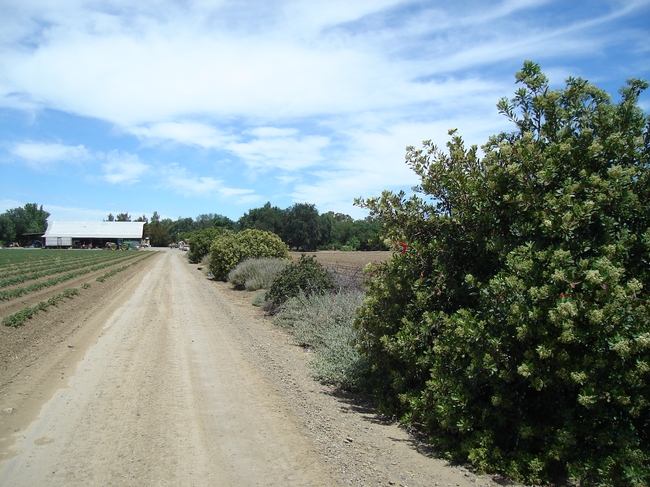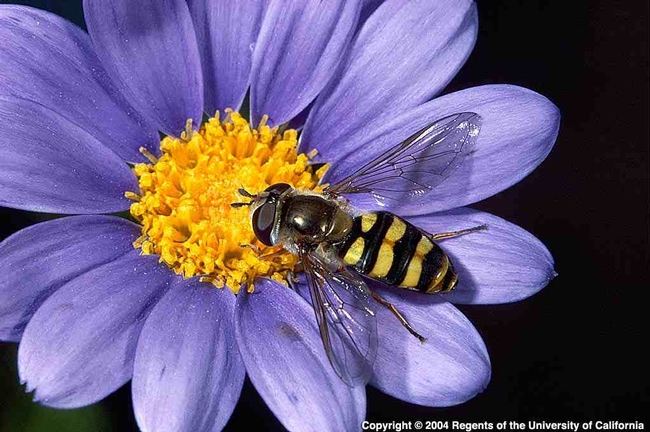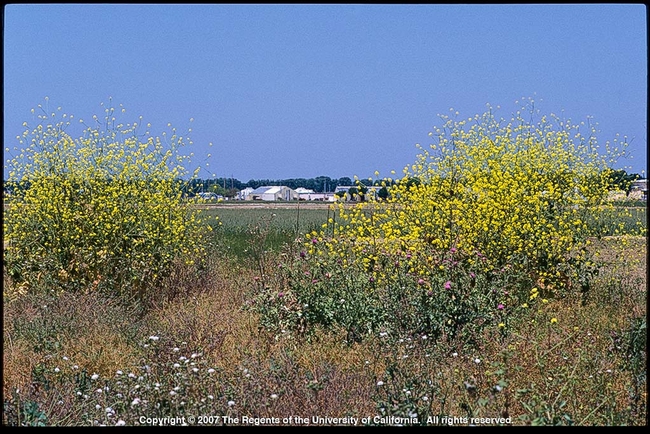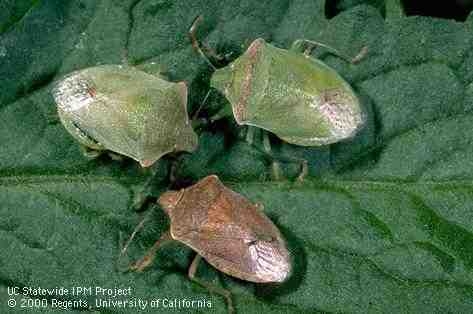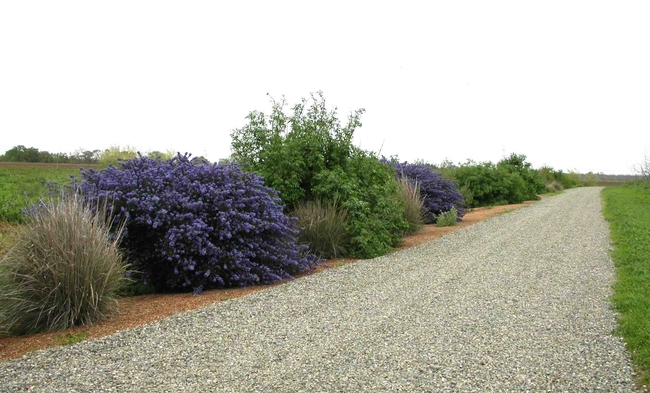Posts Tagged: hedgerows
Birds are beneficial too!
Across the globe, scientists have shown that birds can be farmer allies. Insectivorous birds feed on damaging insect pests in many crops including coffee, cacao, oil palm, corn, cabbage and apples. Raptors, including hawks and barn owls, feed on rodents, including gophers, voles and mice (see blog, Barn owls help clean up rodents naturally).
Despite this deep historic knowledge that birds are important predators of crop pests, over time the perception of birds as natural enemies of pests has been generally replaced with the idea that birds are often major crop pests themselves. Indeed, some bird species — like some types of insects — can cause trouble for farmers, but many others — especially those that eat insects and rodents — can be beneficial.

Do birds control insect pests on farms in California's Central Valley?
They do! Recent studies by Dr. Sacha Heath, UC Davis, and Rachael Long, field crops and pest management advisor, UC Cooperative Extension, showed that birds help control insect pests in walnut orchards. Dr. Sara Kross (UC Davis postdoctoral alumnus, now with Columbia University) showed that birds help control alfalfa insect pests.
Birds are voracious predators of codling moth pests in walnuts
Codling moth is a major worm-like pest that infests walnuts, apples and pears. The larvae go dormant during winter, living in cocoons in crevices in trees. Adult moths emerge in the spring, lay eggs and infest crops.

We evaluated bird predation of codling moth using “sentinel prey” and exclosure cages. We glued codling moth cocoons to walnut trunks and covered them with cages, allowing insects and spiders to access the cocoons, but not bird predators. This allowed us to count how many larvae were eaten inside and outside of the cages to estimate pest reduction by birds.


What did we find?
Natural enemies, like parasitic wasps and lacewings, alone reduced codling moth larval numbers by 11%; adding birds into the pest control system reduced them by 46%! Nuttall's woodpeckers and white-breasted nuthatches did a lot of the work; these birds travel up and down the trunks of trees, searching for insects.
Above, a white-breasted nuthatch preys on a codling moth larva “sentinel cocoon” on a walnut tree. Video by Sacha Heath.
Alfalfa weevils are no match for insectivorous birds
Alfalfa weevils are key pests of alfalfa, reducing yields and hay quality if left uncontrolled. Dr. Sara Kross looked at bird predation of this pest by excluding birds from alfalfa plants via cages, and counting the number of weevils inside and outside the cages. She found that birds reduced the number of weevils by more than 30%, showing their importance in helping to protect alfalfa from this serious pest.

Does field edge habitat, like hedgerows, help attract beneficial birds?
Yes! Hedgerows are important habitat for beneficial birds, serving as nesting, foraging and roosting sites. In a study in the Sacramento Valley, crop margins with hedgerows, tree lines and riparian buffers harbored up to six times more birds and up to three times more bird species than bare or weedy margins.
Walnut orchards adjacent to hedgerows and riparian areas had higher numbers of beneficial birds along with more species. In alfalfa, there were more beneficial birds in fields when at least two tall trees were present along the field edges. More beneficial birds were associated with better pest control, that is, fewer codling moth cocoons and alfalfa weevils.

Birds have large territories, fly long distances, and are influenced by what happens on the farm as well as by what happens in the landscape around the farm. For example, we found that codling moth predation by birds greatly increased in walnut orchards as the amount of habitat in the landscape around the orchards increased (including hedgerows, tree lines, riparian and oak woodlands, and grasslands).

Will hedgerows increase the numbers of pest birds?
Pest birds are present on farms regardless of field edge habitat (such as weedy vegetation or hedgerows). Cases will be different, depending on the crop, but in the fields and orchards of Yolo County, researcher Hillary White (formerly with UCCE and now with U.S. Fish and Wildlife) found that three of the most common avian crop pests (American crow, red-winged blackbird and Brewer's blackbird), were up to 10 times more abundant in agricultural fields with bare or weedy margins than in fields with hedgerows.

What can I do to attract beneficial birds to my farm?
Our avian research team has been quantifying the conditions under which birds are helpful or harmful to growers. We are looking for ways to help farmers create bird habitat on their farms to harness the beneficial pest control services birds can provide, while also protecting crops from the damaging effects of some bird species. This information is available in the new publication “Supporting Beneficial Birds and Managing Pest Birds,” co-authored by the Wild Farm Alliance and Drs. Kross and Heath, and technically advised by UC Cooperative Extension and several farmers. This is a user-friendly guide for farmers and conservation practitioners, with the goal of co-managing farmlands for biodiversity and farming.

Dr. Sacha Heath received her PhD from UC Davis's Graduate Group in Ecology and will soon be starting a postdoctoral fellowship with the Living Earth Collaborative in St. Louis, Missouri.

A white-breasted nuthatch preys on a codling moth larva “sentinel cocoon” on a walnut tree. (Video still: Sacha Heath)
Good news for hedgerows: No effects on food safety in the field
Hedgerows enhance wildlife abundance and diversity around farmland without contributing to food safety problems in field crops, according to a new study published by a team of University of California researchers. The UC Agriculture and Natural Resources and UC Davis study documented that field edge plantings around farms are generally too narrow relative to the surrounding landscape to be a source of rodents and foodborne pathogens.
“This study is particularly pertinent right now when FDA's Food Safety Modernization Act (FSMA) is calling for farmers to co-manage wildlife and agriculture, instead of clear cutting wild habitat around their crops,” said co-author Rachael Long, UC Cooperative Extension farm advisor in the Sacramento Valley. “Our paper provides support for this ruling, showing that the presence of hedgerows does increase wildlife diversity, but does not increase wildlife intrusion into the fields and, more importantly, does not increase the prevalence of animals carrying foodborne pathogens.”
This is good news for hedgerows, rows of shrubs, trees, grasses and flowers that are planted on field edges. The plants bordering crop fields provide habitat and floral resources for beneficial insects, such as bees and natural enemies, that help with pollination and biocontrol of pests in adjacent crops. Hedgerows also help enhance biodiversity – especially for insect-eating birds – help reduce wind and soil erosion, and protect water quality.
The two-year study in Sacramento Valley walnut orchards and processing tomato fields was led by Long and Roger Baldwin, UC Cooperative Extension vertebrate pest control specialist at UC Davis, former graduate student Laurel Sellers, the Western Center for Food Safety at UC Davis's Michele Jay-Russell, Xunde Lib and Edward R. Atwill, and Richard M. Engeman of USDA National Wildlife Research Center.
The study, titled “Impact of field-edge habitat on mammalian wildlife abundance, distribution, and vectored foodborne pathogens in adjacent crops,” was published in the February 2018 Crop Protection (Sellers et al. 2018).
Elsevier is providing 50 days of free access to this article. Anyone clicking on the following link before March 31, 2018, will be taken directly to the article on ScienceDirect. No signup or registration or fees are required. Simply click and read at https://authors.elsevier.com/c/1WXU~xPFYej~4.
This journal article supports a growing body of literature suggesting that plantings along the edge of fields do not substantially attract wildlife species that intrude on fields and transfer foodborne pathogens. For example, in a 2015 study, UC Davis researchers found more food pathogens when wildlife habitat was reduced on farms. This may be attributed to the vegetation filtering pathogens, a better breakdown of pathogens in diverse environments, and that removing vegetation may not deter wildlife from entering farm fields.
Relative to the larger crop acreage, hedgerows and similar field-edge habitats are generally too linear and small to serve as a significant source of rodents to damage nearby crops. However, cottontail rabbits favor hedgerows, and can sometimes cause damage to adjacent seedling crops.
“Overall, we found risk of crop loss or contamination of foodborne pathogens in crops bordered by hedgerows wasn't significant in our study in the Sacramento Valley, although potential damage could vary by the stage and type of crop and wildlife species present,” Long said. She will be presenting this work at the 28th Vertebrate Pest Control Conference, which will be held in Rohnert Park Feb. 26 to March 1.
In its Standards for the Growing, Harvesting, Packing, and Holding of Produce for Human Consumption, the U.S. Food and Drug Administration says, "We continue to encourage the co-management of food safety, conservation, and environmental protection.”
Further reading:
Hedgerow benefits align with food production and sustainability goals. http://calag.ucanr.edu/archive/?article=ca.2017a0020
Comanaging fresh produce for nature conservation and food safety. http://www.pnas.org/content/112/35/11126
X
Hedgerows next to crops can enhance pest control
Research has shown that hedgerows of native California flowering shrubs planted along the edge of a crop field helps keep crop pests under control by increasing the activity of natural enemies.
UC Agriculture and Natural Resources and UC Berkeley researchers analyzing hedgerows in Yolo County have found that not only are farmers diversifying their land by planting hedgerows, but those hedgerows are attracting natural enemies that provide economic benefits.
The two-year study of hedgerows planted adjacent to processing tomatoes showed higher numbers of natural enemies such as lady beetles (aka lady bugs) and fewer crop pests compared with conventionally managed field crops edged with residual weeds.
The researchers discovered that the increase in natural enemy activity in the hedgerows extended 600-feet into adjacent tomato crops and resulted in a reduction of aphid pests and an increase in stink bug egg predation by parasitoid wasps. Tomato fields adjacent to hedgerows required fewer pesticide treatments than the tomato fields without hedgerows.
The scientists concluded that hedgerow restoration on field edges could enhance pest control, reducing the need for chemical pest control, as reported in the Journal of Agriculture, Ecosystems and the Environment.
Plant selection is the key for enhancing beneficial insects on farms, the researchers found. Many natural enemies in the adult stage need nectar and pollen to survive and reproduce. For example, syrphid fly larvae are voracious predators of aphids, but the adult syrphids feed entirely on flowers. Therefore, a hedgerow planted on a field edge needs to include a seasonal range of flowering plants so floral resources are always or usually available for natural enemies. Drought-tolerant plants that thrive in hedgerows include California buckwheat, coffeeberry, toyon, redbud, coyote brush, elderberry, California lilac, and purple needlegrass.
Additional research has shown that hedgerows are important for pollinators, such as native wild bees, that feed on flowers and nest in the ground or holes in plant stems. More wild bees are present on farms with hedgerows than with conventionally farmed field edges. Native bees are important in crop pollination, especially with the decline of the honey bee population.
Hedgerows also provide wildlife habitat, especially for migratory songbirds that call the Central Valley their home. They do not seem to attract flocking birds, such as starlings, as these bird pests cue in on farm fields regardless of field-edge habitat. Likewise, rodents use landscapes on a much larger scale and appear to gravitate toward crops regardless of field-edge habitat. Weeds show up regardless of field-edge habitat, and need to be controlled.
Hedgerows cost about $4 per linear foot to plant and manage for the first three years for a single row of shrubs and native grasses about fifteen feet wide. The Natural Resources Conservation Service (NRCS) offers cost-share programs through USDA's Environmental Quality Incentives Program (EQIP) that covers about 50 percent of the establishment costs. However, due to less pesticide use, a hedgerow can pay off in about 15 years. Add pollination services in areas without an adequate number of honey bees for crop pollination, and that time can be significantly reduced.
With a grant from the California Department of Pesticide Regulation, the Yolo County Cooperative Extension Service seeks to spread the word about the ecosystem service benefits provided by hedgerows planted on farmland. During the past two-years, the researchers hosted workshops in Northern California on the value of hedgerows on farms, reaching hundreds of farmers and landowners. The researchers also offer advice on hedgerow plantings, including plant selection and how to establish and manage hedgerows. Planting hedgerows does not take land out of production; it's using areas that cannot be farmed, such as along fence lines or terraces from land leveling, and providing economic benefits.
More information on hedgerows is available at http://ceyolo.ucanr.edu/Custom_Program/Hedgerows/. The principal investigator is Rachael Long, Yolo County farm advisor.
Additional examples of hedgerows on Yolo County farms:

Hedgerow planted in western Yolo County.

Hedgerow3
Hedgerows enhance bird abundance and diversity on farms
California’s Central Valley is home to a rich diversity and solid abundance of birds. Many are year-round residents, while others are migrants that winter in our valley or travel to destinations further south. Currently more than 400 species of birds call the Central Valley their home; these include raptors, songbirds, ducks, geese, shorebirds, hummingbirds, and others. (Download a checklist of Central Valley birds here.)
All birds depend on habitat for food, shelter and nesting sites. With a decline in habitat in the Central Valley, primarily due to agricultural expansion, urbanization and water diversions, there has been a significant decrease in the numbers and types of birds. Many bird species are now endangered, threatened or listed as species of special concern. Approximately 36 percent of our state’s historical grasslands, 9 percent of the original wetlands, and 2 to 7 percent of the original riparian forests remain. The Central Valley alone has lost more than 90 percent of the riparian, oak woodland and shrub land habitats.
Despite this loss and fragmentation of habitat, many birds continue to use remnant or restored riparian and upland vegetation around farms. Crops such as rice and alfalfa also provide important habitat and foraging areas for birds. Interest is also surging in restoring lands to enhance habitat for birds, including planting hedgerows of California native shrubs and grasses along field edges.
In a recent study by UC Cooperative Extension and Audubon California in Yolo County, researchers determined that hedgerow plantings along field margins helped increase the abundance and species richness of birds on farms, both for winter migrants and year-round species. Their data analyses, examining farms with and without hedgerows, showed that the presence of hedgerows tripled bird abundance and doubled bird species richness in these linear habitat features, but did not increase the bird abundance in the adjacent crops. Of the 2,203 birds counted during the winter and spring of 2011-12, hedgerows drew 41 species of birds, as compared to 22 species in control areas (weedy, semi-managed field edges). In addition, more than three times as many birds used the hedgerows during wintertime, compared to the spring breeding season. This highlights the importance of this habitat for migrating and overwintering birds.
Of significant interest was the finding that bird pest species were using crops regardless of field edge habitat. That is, crop fields with hedgerows showed the same numbers of bird pest species (such as blackbirds that can damage seed crops), compared to crop fields without hedgerows. The researchers observed a total of 1,642 birds, representing 30 species using the adjacent agriculture fields. The minimal species overlap indicated that a different bird community was using crop fields, regardless of the presence of hedgerows. The researchers also found that crops were more heavily used in the winter than during the breeding season.
Hedgerows provide a variety of ecosystem services in agricultural landscapes, such as attracting native bees to enhance pollination and natural enemies to control pests in adjacent crops. Birds also feed on insects and rodents, potentially helping with pest control in crops. The value of hedgerows on farms for enhanced biodiversity and ecosystem services will hopefully encourage more landowners to establish them on field edges for conservation purposes.
For more information on establishing hedgerows on farms, download the free UC ANR publication Establishing Hedgerows on Farms in California. A more thorough discussion of the study results highlighted in this blog will be published in the upcoming December 2012 issue of the California Society of Ecological Restoration newsletter, Ecesis. A conservation innovation grant from the Natural Resource Conservation Service will help expand and continue this important research.
Hedgerows enhance beneficial insects on farms in California’s Central Valley
Hedgerows are rows of trees, shrubs, forbs and grasses that surround farm fields. They may be remnants of existing vegetation from cleared lands, a result of natural plant dispersal, or established via direct plantings.
They’ve been in existence for thousands of years with many benefits including serving as wind breaks, helping to reduce soil erosion, and providing habitat for wildlife. All of this helps protect our water and air quality as well as enhances biodiversity.
More recently, studies have shown that hedgerows of California native flowering shrubs planted on field crop edges can enhance beneficial insect activity on farms, possibly leading to biological pest control in adjacent crops. This valuable ecosystem service could lead to reduced insecticide use on farms, possibly enhancing environmental and worker health and safety issues and provide cost savings to growers. for thousands of years with many benefits including serving as wind breaks, helping to reduce soil erosion and providing habitat for wildlife. All of this helps protect our water and air quality as well as enhance biodiversity.
In a study published in the 2011 October-December edition of California Agriculture by Morandin et al., plantings of elderberry, toyon, coffeeberry, coyote brush, California buckwheat and California lilac on field crop edges attracted significant numbers of beneficial insects. Lacewings, ladybugs, parasitic wasps and syrphid flies, all important natural enemies of crop pests, appeared. Most beneficial insects were found on the plants during bloom, with the floral resources providing many adults the needed nectar and pollen to help them survive and reproduce. Although some pests were found in the hedgerows, nearly 80 percent of the total insects found were natural enemies.
In contrast, an opposite trend was found for weedy field edges with more pests detected in the weeds than beneficial insects. In particular, weeds such as mustard, malva and wild radish are hosts to pests such as cucumber beetles, flea beetles, lygus and stinkbugs that can cause significant crop losses. Replacing this weedy vegetation with managed vegetation such as California flowering shrubs and native perennial bunch grasses will help rid farms of hosts that enhance pest numbers while at the same time increase beneficial insect activity.
The extent to which enhanced pest control occurs in adjacent crops is still under investigation. However, research to date shows that hedgerows aren’t concentrating beneficial insects; instead they’re actually exporting them into adjacent crops. That is, higher numbers of beneficial insects have been found in crops adjacent to hedgerows of flowering shrubs than weedy field edges. Data are still being collected on impacts to pest control.
The enhanced biodiversity and potential ecosystem service benefits of hedgerows have prompted the USDA Natural Resource Conservation Service to support growers in planting native shrubs and perennial grasses on their farms. In 2009, 13 miles of hedgerows were established on California farms compared to 3 miles in 2005, so interest is growing. In particular, planting California native flowering shrubs and forbs for attracting native bee pollinators for enhanced pollination in adjacent crops is gaining significant attention. Recently the USDA approved 90 percent cost-share programs for pollinator hedgerows.
More information on plant selection, establishment practices and costs for planting hedgerows on farms can be found in UC ANR publication number 8390, available as a PDF or e-book: Establishing hedgerows on farms in California.











